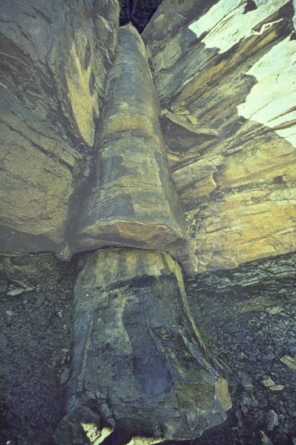 |
The term "polystrate" (pah-lee-strat-ah) consists of two words, poly meaning 'many', and stratum meaning layer. So a polystrate fossil is a fossil that runs through multiple layers of rock. I have never met anyone that denies that polystrate fossils exist, but the debate claws come out when discussing how polystrate fossils can exist when the earth's rock layers are religiously claimed to be millions of years in age. (See "Lies of Evolution: Old Rock Layers" here at creationliberty.com for more details) In this article, we will explain how tree fossils are found to be standing vertically up through multiple rock layers. As you can see, this tree is in a coal seam at the bottom, runs through multiple rock layers in the middle, and ends up in a separate coal seam at the top. Though unexplainable by the religion of evolution, let's look at some simple examples in nature of how these trees like this one end up buried. |
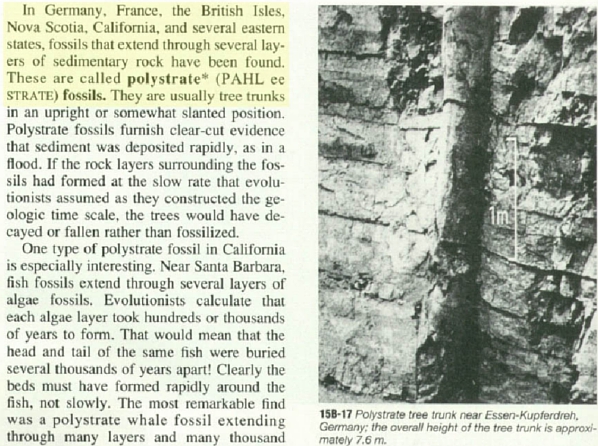
"For example, the cliffs at Joggins in Nova Scotia reveal abundant polystrate tree fossils, as does the hillside at Specimen Ridge in the Yellowstone National Park in the USA. The Joggins site in particular attracted the attention of early geologists such as C. Lyell and J.W. Dawson, who reported |
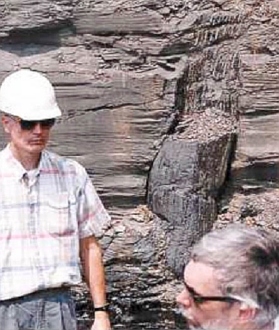 |
It is important to note that these polystrate trees are petrified (i.e. turned to stone). Surprisingly, it is still a common belief by evolutionists today that petrification takes millions of years to occur.
The following quotation is from a book with an interview with an evolutionaist and scientist named Carl:
"'Let me get this right. This area was at one time fertile enough to support forests of trees. At another time, it was the bed of some ancient sea. The sea diappears, the sea bed dries up, and presto, you've got petrified wood.' Carl laughed. 'Well, that's basically it, butI wouldn't use the word presto. It probably takes millions of years. '"
-David Bloom, Labyrinth: Libyan Odyssey, iUniverse, 2005, p. 50, ISBN: 9780595363698
Due to the lies of the evolutionary religion, this is still a common teaching today, even in "informative" travel guides:
"Petrified Forest: This is a national park. It is in Arizona. It has beautiful rocks and hills. Many rocks were once pieces of wood. Butthey became petrified . That means they turned to stone.This takes millions of years. "
-Sean Price, Route 66: America's Road, Heinemann-Raintree Library, 2007, p. 8, ISBN: 9781410926975
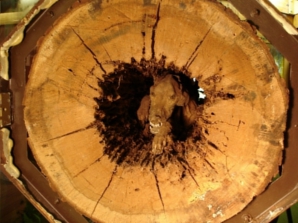 |
This is "Stuckey," the dog that was petrified inside of a tree trunk. He is now on display at the Southern Forest World Museum in Waycross, Georgia. Did this dog sit in this tree trunk for millions of years waiting to turn to stone so he could be perfectly preserved? After seeing this, anyone with half a brain can understand that decay would prevent preservation of bio-material in petrification. Turning to stone must occur rapidly, or nothing recognizable would be preserved. |
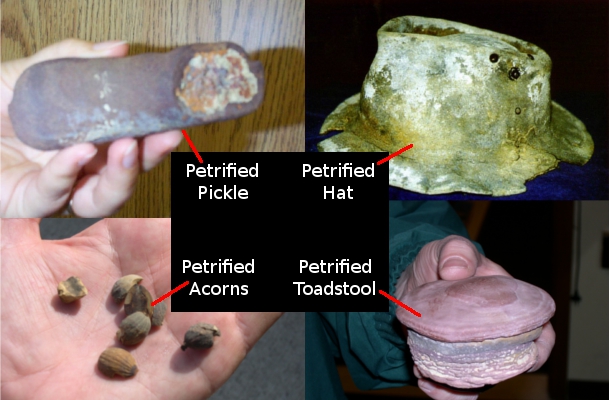

Petrification can take months, years, or centuries, depending on the geological conditions, amount of oxygen, and of course, the amount of water. So what event in history would we relate to having dumped a huge amount of water over so many plants and animals that we have discovered petrified all over the world?
|
Let's get back to the petrified trees, and talk about an interesting phenomena that occured after Mount St. Helens erupted in 1980. The image here shows a small sample of the millions of trees that were blown down as a result of the volcanic eruption.
An estimated 1 million trees were blown into the nearby Spirit Lake. Locals were able to walk across the lake on floating tree mats. |
 |
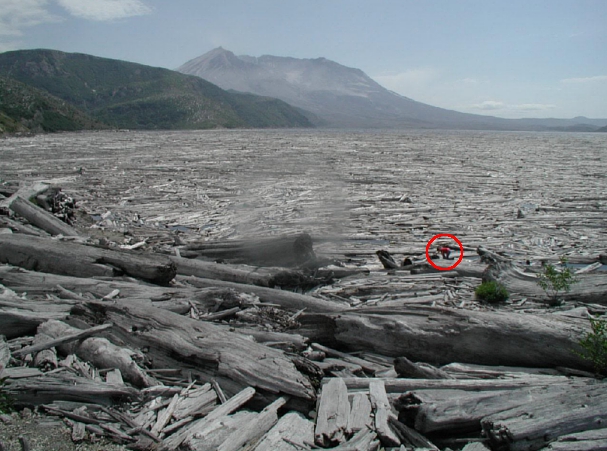
 |
For the next couple of decades, scientists observed the trees to see what would happen to them, and they noticed the trees would roll around back and forth, losing their bark and slowly getting water logged. (i.e. filled up with water) Just like a boat getting filled with water, eventually it will sink, so too the trees filled with water, and they would sink, typically with the heavier end going down first, shifting the tree into a vertical position. |
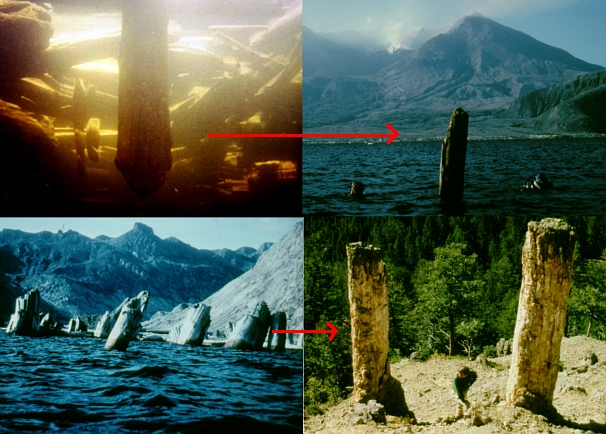
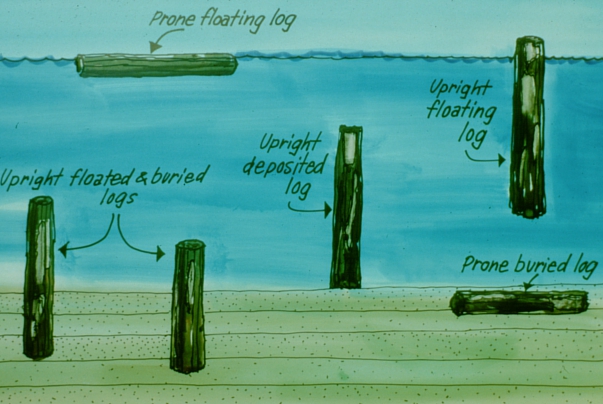
Some of you may question why the evolutionist can't accept this observation, but that's because many people do not understand that evolution is a religious presupposition, not science. When finding polystrate fossils, running through multiple rock layers, in high altitude areas of places like Yellowstone National Park for example, it indicates that a lot of water had to be covering very high places. The problem with this explanation is that it's most easily and logically explained by a global flood, which matches far too closely with the Bible for their comfort, and so for the evolutionist, they are required to religiously reject the concept, keeping their thought-processes confined to the evolutionary box.
So what are typical answers to this by evolutionist documentation? Though it is not the most reliable source, Talk Origins Archive (a very religiously zealous evolutionary website) posted an article on this subject, and after many long-winded paragraphs, we read the following:
"[John William] Dawson (1868) considered and rejected anything but an in situ formation for these fossils... Given thatan 'in place' occurrence was convincingly determined by observations made in the 19th century for this and many other 'fossil forest' localities, it is surprising that these conclusions have not been recognized by modern "young Earth global flood" [YEGF] creationists as clear evidence of non-global-flood deposition for much of the geologic record."
-Andrew MacRae, "Polystrate Tree Fossils," Talk Origins, retrieved Dec 29, 2012, [http://www.talkorigins.org/faqs/polystrate/trees.html]
| All he said was that a man in the 19th century simply said that those trees just grew there. (i.e. in situ, as I mentioned earlier in the article) The article does not even begin to answer the problem, and mostly just ridicules anyone who disagrees with an evolutionary explanation for it. To be more direct, it is an elitist article that denies us any reasonable explanation that can begin to compare to the scientific observation I just demonstrated in this article. | 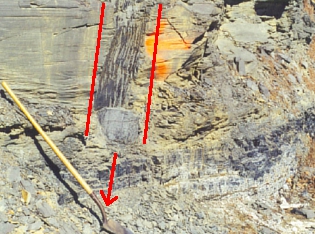 |
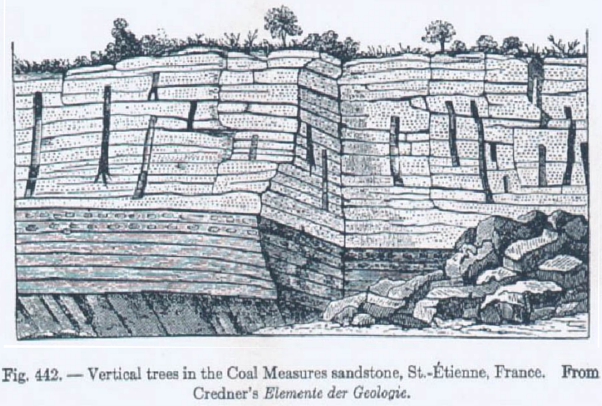
(See "Yellowstone National Park (U.S.) Fossil Forests," Talk Origins, retrieved Dec 29, 2012, [http://www.talkorigins.org/faqs/polystrate/yellowstone.html])
Evolutionist Don Lindsay tries a different approach, attempting to explain the fossils by citing examples of sand dunes near Lake Michigan covering trees ten meters high in just a few years. He knows this doesn't explain places like Yellowstone, so he puts those into a volcanic burial category. However,
Though many of these men who believe in evolution are very intelligent, there are a number of cases where think, "If I speak, therefore, I answered the problem." In this case, the evolutionists are ignoring the tough problems of this one because there is not an answer coming out of their religious organziations. Even if the church of evolution comes up with an answer, it will still be one that takes extraordinary amounts of imagination, not one that can be demonstrated like the examples of Mount St. Helens.
The problem with polystrate fossils, and the reason religious zealots defending evolution will look over them, is that they are powerful support of what God told us happened in the days of Noah. The Bible even tells us very clearly that men would come in the last days, scoffing at God's Word, purposefully looking over the obvious so they can continue to walk in their own lusts:
Knowing this first, that there shall come in the last days scoffers, walking after their own lusts... For this they willingly are ignorant of, that by the word of God the heavens were of old, and the earth standing out of the water and in the water: Whereby the world that then was, being overflowed with water, perished:
-2 Peter 3:3-6
This know also, that in the last days perilous times shall come. For men shall be lovers of their own selves, covetous, boasters, proud, blasphemers, disobedient to parents, unthankful, unholy, Without natural affection, trucebreakers, false accusers, incontinent, fierce, despisers of those that are good, Traitors, heady, highminded, lovers of pleasures more than lovers of God; Having a form of godliness, but denying the power thereof: from such turn away... Ever learning, and never able to come to the knowledge of the truth.
-2 Timothy 3:1-7













![There is No Saving Grace Without Repentance [creationliberty.com]](../images/store13a.jpg)
![Wolves in Costume: Kent Hovind [creationliberty.com]](../images/store11a.jpg)
![Corruptions of Christianity: Seventh-day Adventism [creationliberty.com]](../images/store09a.png)
![501c3: The Devil's Church [creationliberty.com]](../images/store07a.jpg)
![Feminism: Castrating America [creationliberty.com]](../images/store04a.jpg)







![Why Millions of Believers on Jesus Are Going to Hell [creationliberty.com]](images/store05a.jpg)
![Corruptions of Christianity: Catholicism [creationliberty.com]](http://www.creationliberty.com/images/store14a.jpg)
![False Prophet Profiles: Kim Clement [creationliberty.com]](http://www.creationliberty.com/images/store12a.jpg)
![Christmas: Rejecting Jesus [creationliberty.com]](http://www.creationliberty.com/images/store10a.jpg)
![Christian Music: For The Love of Money [creationliberty.com]](images/store08a.png)
![Psychology: Hoodwinked by the Devil [creationliberty.com]](images/store06a.jpg)
